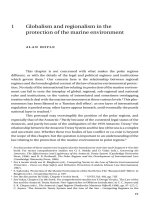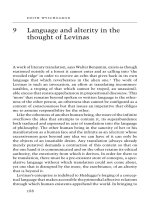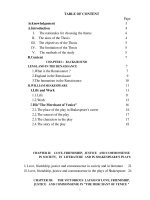ESL podcast 1079 – receiving letters and packages in the mail
Bạn đang xem bản rút gọn của tài liệu. Xem và tải ngay bản đầy đủ của tài liệu tại đây (94.96 KB, 10 trang )
English as a Second Language Podcast
www.eslpod.com
ESL Podcast 1079 – Receiving Letters and
Packages in the Mail
GLOSSARY
letter – written correspondence sent through the mail
* Email is faster, but it’s more fun and interesting to receive a letter in the mail.
package – a box that contains items, especially sent through the mail
* In the weeks before Christmas, the Post Office delivers a lot of packages with
gifts.
envelope – a folded piece of paper that creates a pocket and has an end that
glues down to close the pocket, used to hold a letter or other papers when they
are sent through the mail
* Place the stamp in the upper right-hand corner of the envelope.
postmark – an ink mark placed over the stamp on an envelope, used to show
which branch of the post office processed the mail and when, so that the stamp
no longer has value
* There’s no return address, but the postmark shows that the card was sent from
Hawaii.
overdue – past the deadline; something that should have been submitted or
completed earlier
* The car already has 11,500 miles on the odometer and the 10,000-mile car
maintenance is overdue.
to deliver – to bring and give something to the buyer or recipient
* Does the restaurant across the street deliver to our office building at lunchtime?
postage – money paid to have a letter or package delivered through the mail
* Let’s weigh the envelope to find out how much postage is required.
misdelivered – given to the wrong person; delivered to an address that is
different from the one written on the envelope or package
* The neighbor brought over a bill of ours that was misdelivered to her home.
overnight delivery – arriving within 24 hours of being sent; sent through a
delivery service so that something arrives the next day
* They need these papers right away, so please send them using overnight
delivery.
1
These materials are copyrighted by the Center for Educational Development (2015). Posting of
these materials on another website or distributing them in any way is prohibited.
English as a Second Language Podcast
www.eslpod.com
ESL Podcast 1079 – Receiving Letters and
Packages in the Mail
expedited – rushed; completed more quickly than usual; sped up
* Normally, it takes a few weeks to get a new passport, but if you need it right
away, you can pay more for expedited service.
perishable – decaying, rotting, or going bad very quickly
* The milk and meats are perishable, so please put them in the fridge as soon as
possible.
time-sensitive – required at a particular time, or with a very short period of time
in which something can be used
* These enrollment forms are time-sensitive and must be submitted by March 23.
to be forwarded – to be resent to someone else after an initial delivery, usually
done when a person or business has moved to a new address
* Please make sure that these documents are forwarded to the correct
department.
delivery confirmation – a service that provides a code to the sender, who can
enter that code on a website to determine whether and when a letter or package
was delivered
* When sending merchandise through the mail, it’s a good idea to pay a little
more for delivery confirmation, so you can prove that it was delivered.
mystery – something that is unknown, but that one wants to know; the unknown
answer to a riddle or question
* In this novel, the identity of the murderer is a mystery until the very last page.
to speculate – to wonder or guess about something without clear evidence or
proof
* They spent hours speculating about the existence of ghosts.
2
These materials are copyrighted by the Center for Educational Development (2015). Posting of
these materials on another website or distributing them in any way is prohibited.
English as a Second Language Podcast
www.eslpod.com
ESL Podcast 1079 – Receiving Letters and
Packages in the Mail
COMPREHENSION QUESTIONS
1.
a)
b)
c)
What does Celeste mean when she says, “Those photos are overdue”?
The photos should have been received earlier.
The photos are too fragile to send in the mail.
The photos are overdeveloped and have poor coloring.
2.
a)
b)
c)
What information is on the postmark?
The location from where the letter or package was sent.
The type of delivery service that was used.
The sender’s name and address.
______________
WHAT ELSE DOES IT MEAN?
letter
The word “letter,” in this podcast, means written correspondence sent through
the mail: “Historians are reading old letters to learn more about life in the 18th
century.” Or, “The bank sent us a letter to let us know that the interest rate will
increase next month.” A “letter” is also one of the 26 written symbols that
represent sounds in the English language: “How old was your daughter when you
started teaching her the letters and numbers?” The phrase “the letter of the law”
means adhering to or following exactly how a law was written, even if that isn’t
exactly what was meant: “Prepare the tax documents to the letter of the law, or
we might have problems with the government.” Finally, the phrase “to the letter”
means exactly or precisely: “We followed the driving directions to the letter, but
we still got lost.”
to be forwarded
In this podcast, the phrase “to be forwarded” means to be resent to someone
else after an initial delivery: “Any mail sent do our old address will be forwarded
automatically to our new address.” The phrase “to look forward to something”
means to anticipate something, or think about something that will happen, and be
pleased and excited about it: “We are all looking forward to your visit next
month.” The phrase “from that time forward” means beginning at that time and
continuing to the present: “From that time forward, he never questioned her
expertise again.” Finally, “forward-thinking” means thinking about the future and
planning for the future: “We have a forward-thinking management team that’s
always planning the company’s next steps.”
3
These materials are copyrighted by the Center for Educational Development (2015). Posting of
these materials on another website or distributing them in any way is prohibited.
English as a Second Language Podcast
www.eslpod.com
ESL Podcast 1079 – Receiving Letters and
Packages in the Mail
CULTURE NOTE
Suspicious Packages
A “suspicious package” is an envelope or package sent through the mail that
“raises suspicion” (makes people feel uncomfortable because there seems to be
a problem), specifically because it might contain a dangerous chemical or a
“bomb” (something that can explode, causing injury or death).
People who work in “mail rooms” (departments that sort a large amount of mail
and send letters and packages to the appropriate recipients) are trained to “spot”
(find and identify) suspicious packages. They look for oil “stains” (marks) or
“discoloration” (spots of a different color) on the envelope, or the use of large
amount of tape or string. They also look for packages that smell strange or that
have an unusual shape. Other signs of suspicious packages are addresses that
hare “handwritten” (not typed) with strange, misspelled addresses, no “return
address” (the name and address of the sender), and envelopes with “excessive
postage” (far too many stamps). Often the suspicious packages are marked with
phrases like “confidential,” “private,” or “for (a certain person’s) eyes only,”
meaning that the sender wants only the recipient to open the envelope or
package.
People who receive a suspicious package are advised to stop “handling”
(touching and moving) the package immediately. They should leave the room or
building and call “9-1-1” (the emergency phone number that puts people in touch
with the police and other emergency services) as soon as possible. Then the
police will send a “bomb squad” (people who are trained to “deactivate” (make
inactive) explosive devices) to the site to further evaluate the envelope or
package.
______________
Comprehension Questions Correct Answers: 1 – a; 2 – a
4
These materials are copyrighted by the Center for Educational Development (2015). Posting of
these materials on another website or distributing them in any way is prohibited.
English as a Second Language Podcast
www.eslpod.com
ESL Podcast 1079 – Receiving Letters and
Packages in the Mail
COMPLETE TRANSCRIPT
Welcome to English as a Second Language Podcast number 1,079 – Receiving
Letters and Packages in the Mail.
This is English as a Second Language Podcast episode 1,079. I’m your host, Dr.
Jeff McQuillan, coming to you from the Center for Educational Development in
beautiful Los Angeles, California.
Visit our website at ESLPod.com. Become a member of ESL Podcast. All the
cool kids are doing it. Go to ESLPod.com for more information.
On this episode, we have a dialogue between the Celeste and Anwar about
getting things in the mail – the old kind of mail, you know, not email. Let’s get
started.
[start of dialogue]
Celeste: Did the mail come?
Anwar: Yes, you got some letters and a package.
Celeste: Oh, I hope that one of those envelopes has the photos Naomi promised
us. Did you notice the postmark?
Anwar: No, but they’re sitting in the hall.
Celeste: Those photos are overdue and should have been delivered days ago.
Naomi thought she might not have put enough postage on the envelope, but I
thought it must have been misdelivered.
Anwar: You can look at it yourself. The package you received was sent using
overnight delivery.
Celeste: I wonder who sent it and why they sent it using expedited service.
Anwar: I don’t know. Why don’t you go look?
Celeste: I wonder if there’s anything perishable in it or that’s time-sensitive in
some way.
5
These materials are copyrighted by the Center for Educational Development (2015). Posting of
these materials on another website or distributing them in any way is prohibited.
English as a Second Language Podcast
www.eslpod.com
ESL Podcast 1079 – Receiving Letters and
Packages in the Mail
Anwar: I have no idea. There’s also a letter that’s been forwarded from our old
address that has delivery confirmation.
Celeste: Oh, I wonder what that could be.
Anwar: You know what?
Celeste: What?
Anwar: All of those mysteries can be solved if you just go and open your mail.
Celeste: I know, but isn’t it more fun to speculate?
[end of dialogue]
Celeste begins our dialogue by asking Anwar, “Did the mail come?” Celeste is
asking if the mail has arrived, if it has been delivered. Anwar says, “Yes, you got
some letters and packages.” A “letter” is usually a piece of paper or several
pieces of paper put in an envelope and then is given to the local post office to be
delivered to another location – another house or a business.
An “envelope” (envelope) is basically a folded piece of paper that is glued
together so that you can put another piece of paper, your letter, inside of it. You
can put other things other than letters, pieces of paper with writing on them, in an
envelope. You could also put a photograph in an envelope. Anwar says that
Celeste got some letters and a package. The word “package” (package) is
usually used to describe a box (it could be a small box, it could be a very large
box) that is sent, again, through the mail – given to the post office or some other
delivery service.
Here in the United States, in addition to the post office, we also have other
private companies that will deliver your packages and letters. You have to pay
more money, of course, for that to happen. Celeste says, “Oh, I hope one of
those envelopes has the photos Naomi promised us.” Here we see the word
“envelope” again, and in this case, the envelope has photos in it – or at least,
that’s what Celeste hopes is in the envelope. Celeste says , “Did you notice the
postmark?”
A “postmark” (postmark) is a little mark, usually made with ink, that is put on the
package or the envelope when it is mailed. You put a little piece of paper called a
“stamp” on the envelope or the package, and then the post office puts ink on that
6
These materials are copyrighted by the Center for Educational Development (2015). Posting of
these materials on another website or distributing them in any way is prohibited.
English as a Second Language Podcast
www.eslpod.com
ESL Podcast 1079 – Receiving Letters and
Packages in the Mail
stamp so that you don’t use the stamp again and so that you know what day the
letter or the envelope was processed by the post office in order to be delivered.
In the United States, many times official documents have to be mailed by a
certain date, especially things you’re sending to the government. The
governmnet doesn’t require that the envelope arrive by a certain date, but rather
that it be postmarked by a certain date. So, to pay your income taxes each year,
you have to make sure that the envelope is given to the post office and that the
post office puts a postmark on it no later than April 15th. We would say the
envelope has to be “postmarked” by the 15th of April. So, “postmark” can be
used as a verb, or as a noun to refer to the actual mark of ink on the envelope or
package.
Celeste is asking Anwar if he noticed the postmark, meaning if he looked at it.
Anwar says, “No, but they’re sitting in the hall.” I should mention also that a
postmark also usually contains the location of where the letter or package was
mailed from – the location of the post office. Celeste says, “Those photos are
overdue and should have been delivered days ago.” If something is “overdue”
(overdue), it is past the deadline. It is something that should have been submitted
or should have arrived earlier.
“To be delivered” means to be given to the person for whom the envelope or the
package is intended. Celeste says, “Naomi thought she might not have put
enough postage on the envelope, but I thought it must have been misdelivered.”
“Postage” (postage) is the amount of money that you have to pay in order to
send an envelope or a package. Usually this is done with what are called
“postage stamps” (stamps) which are those little pieces of paper, with usually a
picture on them of a famous person or of a famous place in your country, that are
then placed on the envelope or the package.
Celeste thought the package might have been “misdelivered,” meaning it might
have been given to the wrong person by the post office. That happens of course
sometimes. Anwar says, “You can look at it yourself. The package you received
was sent using overnight delivery.” “Overnight delivery” is when you give a letter
or a package to the post office or to another private delivery service, and that
package or envelope is delivered the next day. In fact, another word for or term
for “overnight delivery” is “next-day delivery,” which is now the more common
term.
Celeste says, “I wonder who sent it and why they sent it using expedited service.”
The word “expedite” (expedite) means to make something go faster. So,
“expedited service” would be delivery service that is faster than normal, faster
7
These materials are copyrighted by the Center for Educational Development (2015). Posting of
these materials on another website or distributing them in any way is prohibited.
English as a Second Language Podcast
www.eslpod.com
ESL Podcast 1079 – Receiving Letters and
Packages in the Mail
than usual. Anwar is clearly not interested in answering all of Celeste’s
questions. He says, “I don’t know” – I don’t know why they sent it using expedited
service. “Why don’t you go look?” meaning stop bothering me and go look at the
package yourself. It’s almost certain that Anwar and Celeste are married.
Celeste says, “I wonder if there is anything perishable in it or that’s time-sensitive
in some way.” Sometimes you’ll use “expedited service” or “overnight delivery”
because you’re sending food that is “perishable” (perishable). Perishable food is
food that has to be put in a refrigerator or a freezer, otherwise, it will go bad. It
will rot.
Some people send food that is perishable in special packages that have ice in
them or some other material that keeps them cold. But, of course, they need to
be placed in a refrigerator or freezer as soon as possible. That’s “perishable
food” – anything that has to be refrigerated or frozen. The opposite would be
“nonperishable food” – food that comes in cans, for example.
Celeste also wonders whether the contents of the package is something that is
“time-sensitive.” If something is “time-sensitive,” it is required to be acted upon or
to arrive within a very short period of time. Something that’s time-sensitive is
something that has to be done right away, or very soon, or by a certain deadline.
Again, Anwar isn’t interested in answering Celeste’s questions. He says, “I have
no idea. There is also a letter that’s been forwarded from our old address that
has delivery confirmation.”
When mail is “forwarded” (forwarded), it is sent to a different address, usually
because someone has moved. If you move from one house or apartment to
another house or apartment, usually the post office will forward your mail to your
new address even though the address on the envelope or package is to your old
address, to the house where you used to live. Usually they’ll do that for three or
six months. After that, they may or may not, depending on how nice of a post
office you have.
“Delivery confirmation” is a special service that the post office provides, as well
as other private delivery companies, where the person who is sending the
package can check to see if the package has in fact arrived – if it has been
delivered. Celeste says, “Oh, I wonder what that could be?” meaning the other
letter that had been forwarded. Anwar says, “You know what?” And Celeste
responds, “What?” Anwar says, “All of those mysteries can be solved if you just
go and open your mail.”
8
These materials are copyrighted by the Center for Educational Development (2015). Posting of
these materials on another website or distributing them in any way is prohibited.
English as a Second Language Podcast
www.eslpod.com
ESL Podcast 1079 – Receiving Letters and
Packages in the Mail
Anwar is getting impatient now with Celeste. He’s telling her to just go and open
the mail so she doesn’t have to keep asking questions wondering what’s in the
package and the letter. A “mystery” (mystery) is something that you don’t know –
something that you want to know, but you don’t have an answer for. We can talk
about a “murder mystery,” where you don’t know who killed a certain person.
Celeste says, “I know, but isn’t it more fun to speculate?” She realizes she can
have her questions answered by just going and opening these letters and
packages, but she thinks it’s “fun to speculate.” “To speculate” (speculate) means
to wonder or guess about something without having any real evidence or proof.
The noun form would be “speculation.”
Now let’s listen to the dialogue, this time at a normal speed.
[start of dialogue]
Celeste: Did the mail come?
Anwar: Yes, you got some letters and a package.
Celeste: Oh, I hope that one of those envelopes has the photos Naomi promised
us. Did you notice the postmark?
Anwar: No, but they’re sitting in the hall.
Celeste: Those photos are overdue and should have been delivered days ago.
Naomi thought she might not have put enough postage on the envelope, but I
thought it must have been misdelivered.
Anwar: You can look at it yourself. The package you received was sent using
overnight delivery.
Celeste: I wonder who sent it and why they sent it using expedited service.
Anwar: I don’t know. Why don’t you go look?
Celeste: I wonder if there’s anything perishable in it or that’s time-sensitive in
some way.
Anwar: I have no idea. There’s also a letter that’s been forwarded from our old
address that has delivery confirmation.
9
These materials are copyrighted by the Center for Educational Development (2015). Posting of
these materials on another website or distributing them in any way is prohibited.
English as a Second Language Podcast
www.eslpod.com
ESL Podcast 1079 – Receiving Letters and
Packages in the Mail
Celeste: Oh, I wonder what that could be.
Anwar: You know what?
Celeste: What?
Anwar: All of those mysteries can be solved if you just go and open your mail.
Celeste: I know, but isn’t it more fun to speculate?
[end of dialogue]
It’s no mystery who writes the wonderful scripts here at ESL Podcast. It’s Dr.
Lucy Tse. Thank you, Lucy.
From Los Angeles, California, I’m Jeff McQuillan. Thank you for listening. Come
back and listen to us again right here on ESL Podcast.
English as a Second Language Podcast was written and produced by Dr. Lucy
Tse, hosted by Dr. Jeff McQuillan. Copyright 2015 by the Center for Educational
Development.
10
These materials are copyrighted by the Center for Educational Development (2015). Posting of
these materials on another website or distributing them in any way is prohibited.









